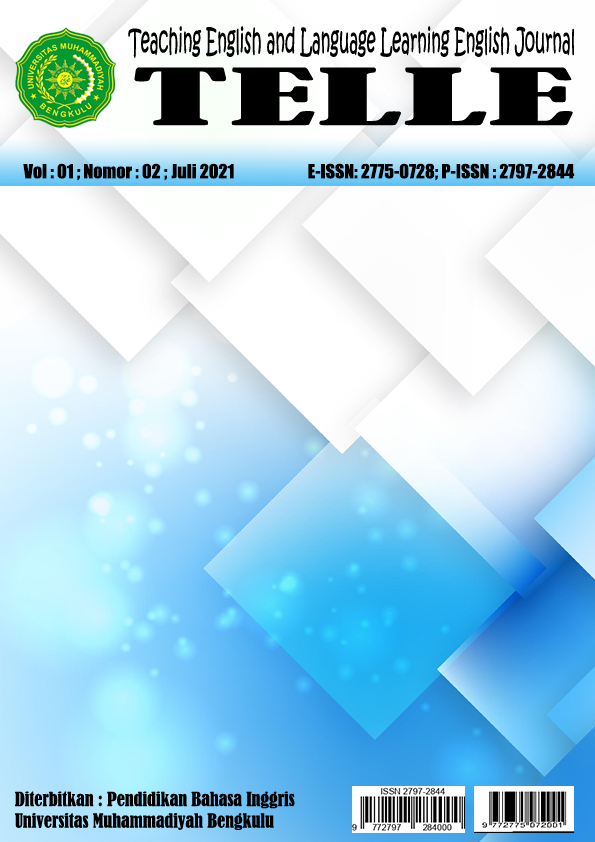EFL COLLEGE STUDENTS' SPEAKING CONSTRAINS IN RESEARCH PROPOSAL SEMINAR PRESENTATION
DOI:
https://doi.org/10.36085/telle.v1i2.1893Abstract
This study is aimed to find out English as a Foreign Language (EFL) college students’ speaking constrains in research proposal seminar presentation. The design of the research was a qualitative descriptive. The subjects of this research were 29 students of English Study Program of Muhammadiyah of Bengkulu who presented their proposal on April 2020 – June 2020. The researcher used observation checklist as the instrument of this research. The checklist was designed based on Gan (2012). The questions were divided into five aspects; limited number of vocabulary, hard to apply grammar rules, and not perfect pronunciation and Intonation. The findings revealed that speaking constrains encountered by the students of English Education Study Program of Muhammadiyah University of Bengkulu in proposal seminar presentation were limited number of vocabulary, hard to apply grammar rules, not perfect pronunciation and intonation. It is suggested that students take a lot of practices and make a good preparation. Structure your talk by the same order that you have structured your research proposal. Moreover, you can also attend English offline academic seminar and watch English seminar on You Tube more frequently.
Key Words: EFL college students, speaking constrains, proposal seminar.References
Al-Mekhlafi, A. M., & Naratnam, R. P. (2011). Difficulties in teaching and learning grammar in EFL context. International Journal of Instruction, 4(2), 69-92. Retrieved from https://files.eric.ed.gov/fulltext/ED522689.pdf
Astrid, A. (2011). Pembelajaran tata Bahasa Inggris secara komunkatif dengan penyajian induktif dan pengintegrasian keterampilan berbahasa: Studi kasus di kelas Bahasa Inggris di IAIN Raden Fatah Palembang. Ta’dib, 16(2), 175-208. Retrieved from http://jurnal.radenfatah.ac.id/index.php/tadib/article/view/60/55.
Bahrani, T., and Sultani.R. (2012). “How to Teach Speaking Skill?†Journal of Education and Practice 3 (2): 25–29.
Ermawati, E. (2010). Using Video Clips to Improve the Speaking Skills of The Students of The Fourth Grade of Sengon Elementary School 3 (Ses 3) In The Academic Year Of 2011/2012.
Gan. 2012. “Understanding L2 Speaking Problems: Implications for ESL Curriculum Development In A Teacher Training Institution In Hong Kongâ€, Australian Journal of Teacher Education, vol. 37, no. 1, pp. 42-56.
Huebener, Theodore. 1965. How to Teach Foreign Language Effectively. New York: New York University Press.
Hamad, M. M. (2013). Factors negatively affect speaking skills at Saudi colleges for girls in the south. English Language Teaching, 6(12), 87-97.
Kayi, H. (2006). “Teaching Speaking: Activities to Promote Speaking in a Second Languageâ€. The Internet TESL Journal, Vol. XII, No. 11, November 2006 http://iteslj.org/
Mahdum. (2017). Constraints in English Speaking: A Case Study on Students of Teacher Training and Education Faculty, Riau University, Indonesia.
Mukminin,A., Noprival., Masbirorotni., Sutarno., Arif, N., & Maimunah. (2015). EFL speaking anxiety among senior high school students and policy. Journal of Education and Learning, 9(3), 217-225.
Nanda. (2017). Students’difficulties In Speaking Skill at The Eleventh Grade of SMA Muhammadiyah 1 Karanganyar In the Academic Year Of 2016/2017.
Sambath and Seturahman (2017). Constraints in Spoken Proficiency: Causes and Remedial Measures.
Sheila. (2015). The Students’ Difficulties in Speaking at The Tenth Grade Of Sma Negeri 1 Sine In 2014/2015 Academic Year.
Tozcu, A and J. Coady. 2004. Succesful Learning of Frequent Vocabulary through CALL also Benefits Reading Comprehension and Speed. Retrieved from http://www.tandfonline.com.
Tetala. 2011. Oral language for today's classroom. Markham, ON: Pippin Publishing.





